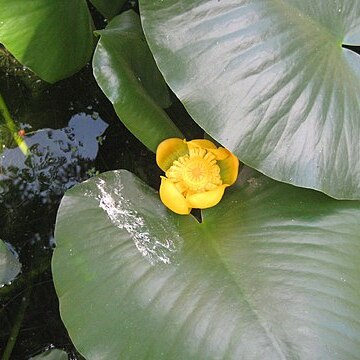Floating and submersed lvs rarely present; emersed lvs mostly 2–4 dm, on stout petioles, the subacute basal lobes separated by a broadly triangular sinus; petioles terete, or oval in cross section; fls 3–5 cm thick; sep 6, yellow within or rarely suffused with purple; anthers 3–7 mm, longer than the filaments; stigmatic disk greenish, 10–15 mm wide at anthesis, mostly 14–18-rayed; fr broadly ovoid, 4 cm, mostly thicker than long. Sluggish streams, less often in ponds; s. Me. to Fla. and Cuba, w. to Wis., Mo., Kans., Tex., and n. Mex. Summer. (N. fluviatilis; N. macrophylla; N. puteorum)
A herb that grows in water. It keeps growing from year to year and spreads over 2.5 m of the water surface. The plant is spongy. It has a creeping rhizome or underground stem and the leaves are large and heart shaped. The leaves are 35-40 cm long by 20-25 cm wide.
